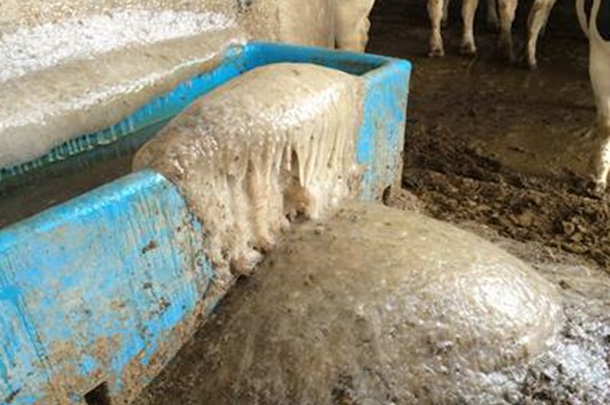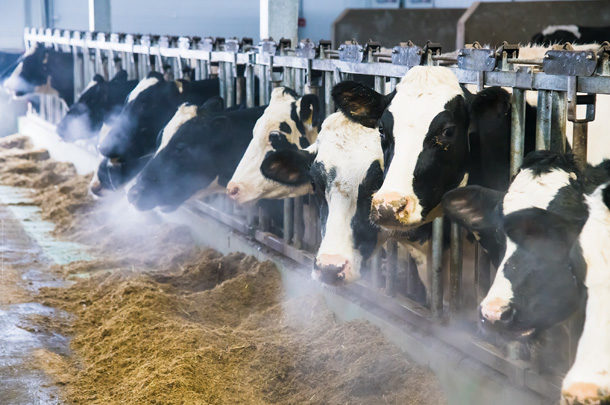Heat stress is a topic regularly addressed for dairy farms as it causes detrimental impacts each year. On the other end of the spectrum is cold stress, a subject that isn’t talked about as regularly but one that can still create some challenges for farms.
Cold stress may not be as prevalent across the U.S. as heat stress, but preventing the impacts of cold stress is still something that will benefit farms and improve overall farm profitability.
Calves and cold stress
When it comes to cold stress, calves are negatively impacted by cold weather more easily as their lower critical temperature (LCT) threshold is at a higher temperature than for cows. The LCT for newborn calves is 60°F. At temperatures less than 60°F, newborn calves require additional energy for maintenance.
When it comes to cold weather, maintaining energy intake is one of the most important aspects of keeping calves healthy and growing. As temperatures get colder, energy needs of calves continue to increase. Therefore, calves in cold environments need additional energy to keep themselves warm in addition to nutrients needed to achieve desired gains.
Additional energy can be provided to calves by feeding fat supplements, increasing the amount of milk or calf milk replacer calves get at each feeding, or adding an additional feeding each day.
Providing a dry and comfortable environment for young calves should be a top priority. Calves should not be exposed to drafty or windy conditions. If calves are housed outside, they need to be able to move out of the elements and away from drafts. Although drafts need to be avoided, ventilation is still important to maintain air exchanges and keep air fresh.
Bedding type and amount are important for keeping calves warm and comfortable. Research has shown that straw provides additional insulation to calves compared to other bedding types during the winter months. Ideally, bedding will be deep enough to allow calves to “nest” in the bedding. When properly bedded, legs of calves should not be visible through the bedding.
Calf blankets are another management tool many farms use during periods of cold weather. Blankets can be a great way to provide some extra warmth for calves, but they do require additional management.
Blankets should be adjusted routinely as calves grow so they are comfortable and do not restrict movement. Blankets also will need to be washed regularly, and for biosecurity reasons, they should definitely be washed between calves.
Cows and cold stress
Cows have a much lower LCT than calves, and high-producing cows will not start experiencing cold stress until about 5°F. Moisture is one of the main factors in determining how well cattle are able to withstand cold temperatures.
When cattle remain dry, they are generally able to handle cold temperatures with minimal impacts. Situations in which cattle get wet, whether it is exposure to rain and/or snow, wet bedding or through routine milking procedures, may result in additional challenges during cold and freezing temperatures.
Housing and management of housing impact how well cows can withstand cold weather and freezing temperatures. Providing shelter from wind and any precipitation, along with maintaining dry bedding, goes a long way in helping cattle handle cold temperatures. As wet hides and lying on wet surfaces require extra energy, it is important to keep cattle dry to reduce any additional increases in energy needs.
One issue that is often not considered is the impact of cold temperatures on the feed cows are consuming. During long stretches of very cold temperatures, edges of silage piles can freeze, potentially leaving chunks of frozen silage in the total mixed ratio (TMR) that can lead to sorting.
Also, even if some dry feeds do not appear to be frozen, they are typically stored outside and are likely the same temperature as the environment. This means that the temperature of the TMR mix itself may be very cold.
Besides cattle having to keep themselves warm from cold environmental temperatures, they also need to warm up the more than 100 pounds of TMR they are consuming each day to over 100°F. When considering the cold temperature of feed cows consume, it is not surprising that the energy requirements of cows is drastically increased during freezing temperatures.
 Waterers and the area around waterers can ice up during extended periods of freezing temperatures, resulting in cattle having limited access to water. Photos courtesy of ADM Animal Nutrition.
Waterers and the area around waterers can ice up during extended periods of freezing temperatures, resulting in cattle having limited access to water. Photos courtesy of ADM Animal Nutrition.
Water
Freezing water may be one of the first things most farmers think about when it comes to cold weather challenges with livestock and for good reason. Water intake is essential for healthy animals and is directly related to feed intake, so it is necessary that cattle continue to have an adequate water supply regardless of the temperature.
Unheated waterers can easily freeze in cold weather, and even heated waterers may ice up during extended cold periods or if they are outside and exposed to cold winds. Waterers should be checked at least twice a day to make sure animals have continued access to water.
Keeping the water itself thawed out is usually the first priority, but access to waterers also needs to be considered. During extended periods of freezing temperatures, ice can build up around waterers and on floors due to splashing and dripping after animals have been drinking. Animals should be able to easily access the waterer without having to stretch to reach or slipping on the floor around the waterer.
Water intake is important for all ages and classes of cattle. Fresh water is just as important for calves and heifers as it is for lactating cattle. Depending on the housing method, heated waterers can be more of a challenge for calves, especially when they are individually housed.
Feeding calves warm water can be advantageous as calves will often drink it more readily, they do not have to spend extra energy warming it up and it will not freeze as quickly as cold water. At a minimum, calves should have access to fresh water at least twice a day.
Things to remember
Focusing on strategies that keep calves and cows warm and dry can help to mitigate some of the challenges that occur during freezing temperatures. Even so, cold weather leads to increased energy needs for both calves and cows. Providing additional energy sources during cold and freezing temperatures is necessary to maintain the health and performance of animals.







